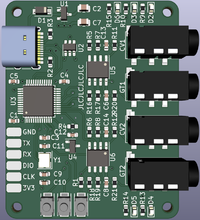Difference between revisions of "MIDItio"
| Line 36: | Line 36: | ||
A = 1 + Rf / R2 | A = 1 + Rf / R2 | ||
| − | If we choose R2 = 9.1 | + | If we choose R2 = 9.1 kΩ, we can calculate Rf |
| − | Rf = (A - 1) * R2 = 0.515 * 9.1 | + | Rf = (A - 1) * R2 = 0.515 * 9.1 kΩ = 4.68 kΩ |
| − | A Rf of 4.7 | + | A Rf of 4.7 kΩ should do nicely. |
=== Schematics === | === Schematics === | ||
Revision as of 01:37, 30 August 2022
MIDItio is a planned USB Midi to CV device. The device will act as a USB MIDI device connected to a USB host. It will be able to run two channels simultaneously with a CV indicating the pitch and a Gate indicating start and stop.
The name MIDItio is derived from MIDI and the Latin "ditio" which means "control".
Planned features are:
- USB MIDI Gadget/Device
- 2 MIDI channels
- Dual pitch CV output (1V/oct)
- Dual gate output
Hardware Design
MCU
The primary concerns dictating the choice of MCU are:
- Built-in USB
- Built-in Digital to Analogue converters (DAC) - preferably 2
- Cost
The STM32L151 fits the bill nicely.
Output Amplifier
Without a boost regulator the highest available voltage on the board is the USB VBUS 5V. That means the output amplifier for the CV's need to map 0-3.3V into 0-5V.
A = 5 / 3.3. = 1.515
The amplification of a non-inverting opamp is:
A = 1 + Rf / R2
If we choose R2 = 9.1 kΩ, we can calculate Rf
Rf = (A - 1) * R2 = 0.515 * 9.1 kΩ = 4.68 kΩ
A Rf of 4.7 kΩ should do nicely.



